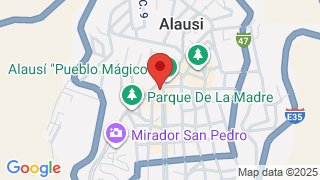Alausí Train Station




The devil's nose train as it is also known goes from this point located 2,200 meters above sea level, facing the Condor hill Puñuna (kichwa: nest or bedroom of condors), it is possible to observe the "Zigzag" of the train that ascends by an erect slope crossing a complex rail system to then descend, one of the most beautiful engineering works and railways of the world done in an amazing mountain.
It is located in the center of Alausí and was built in 1910 and its work was completed 30 years later.
Alausí Train Station
This spectacle is enjoyed from the viewpoint 'Rest of the Devil’ located in Tolte, indigenous community of the Pistishí parish , located 30 minutes away from Alausí, in the province of Chimborazo , was taken advantage of by the locals to start an associative tourism venture.
The initiative was launched in 2009, with a group of nine women from the community sponsored by the Maquita Cusunchic Foundation, but today more than 80 families that live there are involved.
The Alausí train station, according to some authorities of the Parish Board from Pistishí, they was a project for which "in the beginning we were all incredulous, we didn’t think tourists were going to want to come here, then with the train, we discovered in tourism an opportunity to progress and we decided to support this project. ”
Beyond being able to also enjoy the wonderful and charming landscape, among the services offered are: the route along a path that it reaches the viewpoint, horseback riding, visits to farms and a varied typical menu in the restaurant.
The Train Station in Alausí presents a tourist offer that also includes the experience of participating in the daily life of the community members, working at the farms, in addition to sharing the legends of their ancestors and their cultural practices.
In this context, Ángel Satián, native guide, comments that “before the Pistishí parish was a hamlet known as Nariz del Diablo , settled on the banks of the Chanchán river and a landslide in the El Niño phenomenon forced us to leave the settlement and move to this hill where we are currently located. ”
He also recalled that, after relocation, the road (currently with bleachers and handrails) leading to the viewpoint was the section they used to get off with the products harvested on their land to the train station and be able to move to the coast or make exchanges with other merchandise of the saw.
... and was guarded by a tall man with a very pronounced nose, with an elegant frac and black hat, many train workers said that this man once said to them: “Stop! the mountain doesn't want any train to cross it, ”but when they returned with help, he was gone.
"We have chosen to do tourism for the reason that we do not want our people migrate to other cities, in addition to creating sources of work for the new generation, ”he said.
Alausí community tourism
The comuneros have been divided into groups to provide the different community services, while one deals with horseback riding and bicycle through the community, another takes turns serving the cafeteria and another takes care of the routes along the route of the viewpoint and the farms.
For Rosa Sauce, one of the founders of the initiative, her economy changed with the arrival of tourism: “Here the situation was desperate, we only depended on agriculture and for lack of water the production was low, we earned very little, ”he said.
Now she works in the community restaurant where dishes are served as chicken, rabbit and guinea pig broth but with a gourmet style in charge of Chef José Moina. Doña Sauce received the training of the foundation Maquita and, she says, has now become an entrepreneurial farmer.
A second stage of the project is under study by the comuneros, to increase the visits of tourists who currently fluctuate around 700 per month.

Publicado en:
Publicado por:



